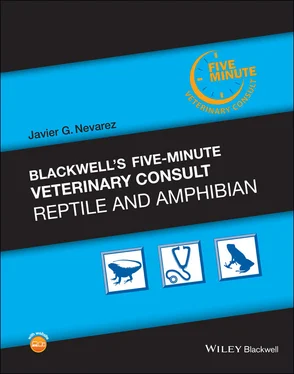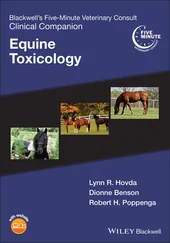Javier G. Nevarez - Blackwell's Five-Minute Veterinary Consult - Reptile and Amphibian
Здесь есть возможность читать онлайн «Javier G. Nevarez - Blackwell's Five-Minute Veterinary Consult - Reptile and Amphibian» — ознакомительный отрывок электронной книги совершенно бесплатно, а после прочтения отрывка купить полную версию. В некоторых случаях можно слушать аудио, скачать через торрент в формате fb2 и присутствует краткое содержание. Жанр: unrecognised, на английском языке. Описание произведения, (предисловие) а так же отзывы посетителей доступны на портале библиотеки ЛибКат.
- Название:Blackwell's Five-Minute Veterinary Consult: Reptile and Amphibian
- Автор:
- Жанр:
- Год:неизвестен
- ISBN:нет данных
- Рейтинг книги:4 / 5. Голосов: 1
-
Избранное:Добавить в избранное
- Отзывы:
-
Ваша оценка:
- 80
- 1
- 2
- 3
- 4
- 5
Blackwell's Five-Minute Veterinary Consult: Reptile and Amphibian: краткое содержание, описание и аннотация
Предлагаем к чтению аннотацию, описание, краткое содержание или предисловие (зависит от того, что написал сам автор книги «Blackwell's Five-Minute Veterinary Consult: Reptile and Amphibian»). Если вы не нашли необходимую информацию о книге — напишите в комментариях, мы постараемся отыскать её.
STAY UP TO DATE ON THE BEST PRACTICES FOR TREATING COMMON DISEASES IN REPTILES AND AMPHIBIANS Blackwell’s Five-Minute Veterinary Consult: Reptile and Amphibian
Blackwell’s Five-Minute Veterinary Consult: Reptile and Amphibian
Blackwell's Five-Minute Veterinary Consult: Reptile and Amphibian — читать онлайн ознакомительный отрывок
Ниже представлен текст книги, разбитый по страницам. Система сохранения места последней прочитанной страницы, позволяет с удобством читать онлайн бесплатно книгу «Blackwell's Five-Minute Veterinary Consult: Reptile and Amphibian», без необходимости каждый раз заново искать на чём Вы остановились. Поставьте закладку, и сможете в любой момент перейти на страницу, на которой закончили чтение.
Интервал:
Закладка:
A vomeronasal organ is present in tuataras, lizards, and snakes, but absent in crocodilians. Its presence is debated in chelonians. Pit organs are openings in the maxillary and/or mandible of boas, pythons, and pit vipers, which serve to provide infrared detection of environmental cues. There are free nerve endings within the pits or scales, and this is thought to be a very sensitive system.
Suggested Reading
1 O’Malley, B. Clinical Anatomy and Physiology of Exotic Species. Edinburgh, NY: Elsevier Saunders, 2005.
2 Jacobson, ER. Overview of Reptile Biology, Anatomy, and Histology. In: Jacobson ER, ed. Infectious Diseases and Pathology of Reptiles: Color Atlas and Text. Boca Raton, FL: CRC Press; 2007: 1–130.
3 Fowler ME, Miller RE. Fowler’s Zoo and Wild Animal Medicine, Volume 8. St. Louis, MO: Elsevier, 2015: Part II: Reptile Groups.
4 Mader DR. Reptile Medicine and Surgery. 2nd ed. St. Louis, MO: Saunders/Elsevier; 2006.
5 Pet Industry Market Size & Ownership Statistics. The 2019–2020 American Pet Products Association National Pet Owners Survey © American Pet Products Association, Inc. https://www.americanpetproducts.org/press_industrytrends.asp.
UVB Lighting Principles for Captive Reptiles
Exposure to ultraviolet B (UVB) light is a critical aspect of reptile husbandry. UVB light supplementation is an absolute requirement for diurnal, herbivorous or omnivorous reptiles. While it is not an absolute requirement for nocturnal and carnivorous species, some may benefit from it. Unfortunately, this is an essential husbandry component that is still lacking in some captive reptiles and its omission contributes to the occurrence of secondary nutritional hyperparathyroidism. One challenge is the difficulty of obtaining easy to follow and accurate information on how to choose and use UVB lights properly. The abundance of misinformation on internet sites and the lack of training of pet store employees are further contributors to this problem. It is therefore essential that veterinarians working with reptiles are able to properly educate clients and provide easy to follow instructions on the use of UVB lights.
UVB LIGHT AND VITAMIN D3
Ultraviolet light is electromagnetic radiation that exists in three main bands: UVA, UVB, and UVC. Each band is characterized by a specific wavelength. UVA has the longest wavelength at 320‐400nm while UVB has a wavelength of 290‐320nm. Both UVA and UVB have low tissue penetration with most light being absorbed at the epidermis. UVA has a wavelength of less than 290nm, the deepest penetration, and is the most harmful. These wavelengths place ultraviolet somewhere between visible light (369‐769nm) and X‐rays (0.01‐10nm). The ozone layer is responsible for filtering the majority of UV radiation hence protecting living organisms from its harmful exposure. UVC is considered germicidal and can have significant harmful effects to living animals while both UVA and UVB have therapeutic and physiologic applications. Still, as we know from human medicine, too much sun/ultraviolet exposure has a slew of negative implications ranging from sunburn to premature aging, and cancer.
UVB light is essential for the synthesis of vitamin D3. Although commonly referred to as a vitamin, D3 is actually a hormone. UVB light from the sun stimulates conversion of 7‐dehydrocholesterol to cholecalciferol (D3) in the skin. Cholecalciferol is then transported to the liver via the blood stream and hydroxylated into 25‐hydroxycholecalciferol (calcidiol), which is then transported to the kidneys for hydroxylation into 1,25‐dihydroxycholecalciferol(calcitriol), the active form of D3. The 25‐hydroxycholecalciferol in the liver is the storage form of D3 and is a natural source of D3 for animals fed whole prey. Plants are a source of ergocalciferol or ergosterol (D2), which is not readily bioavailable to most reptiles and is therefore not an appropriate source of D3 supplementation. Calcidiol, an animal source of D3, is more bioavailable for reptiles.
There are two main sources of UVB, natural sunlight and UVB bulbs. Exposure to natural sunlight is the most efficient way for reptiles to produce adequate levels of D3. However, this is often not possible year round, outside the tropics and some subtropical regions, necessitating the use of artificial UVB light sources.
CHOOSING UVB LIGHTING
There has been a long‐standing debate about the effectiveness and even potential harmful effects of artificial UVB lights. Like the application of any treatment or therapeutic, the use of UVB lights must be in accordance with certain parameters for it to be effective and safe. Nowadays there are high‐quality bulbs in the market that provide adequate UVB while also being safe when used appropriately. UVB bulbs can be further divided into linear fluorescent, compact fluorescents, and mercury vapor. In the future, commercial LED UVB lights may also become available. Fluorescent UVB bulbs provide light in the required wavelength for D3 synthesis but no heat. Mercury vapor bulbs provide both heat and UVB.
There are six main aspects to consider when selecting a UVB bulb:
1 Size/type of the enclosure.
2 Type of material between the bulb and the reptile.
3 Type of bulb.
4 Effective distance of the bulb.
5 Bulb longevity.
6 Species of reptile.
Another consideration is the type of fixture used for the bulb. There are a number of reptile‐specific fixtures that offer the advantage of having reflective materials to increase light reflection and decrease scattered light emission (radiation). Some also have a ceramic base and are more tolerant of higher temperatures produced by mercury vapor bulbs. Reptile‐specific light fixtures or those that reflect light away from the bulb and towards the animal are preferred over plastic fixtures or those without reflective properties.
T8 Linear Fluorescent Tubes
T8 bulbs (25‐mm or 1‐inch diameter) are available in different lengths and fit into standard aquarium or reptile hoods. Some manufacturers further classify their bulbs by a number system ranging from 2.0 to 10.0. This number represents the percentage of light that is emitted in the UVB spectrum. A 5.0 has 5% of the emitted light in the UVB spectrum; a 10.0 has 10% UVB emission, and so on. Arcadia® has simplified the process by simply stating the percentage of UVB emission with their bulbs ranging from 6% to 14%.
Being a longer bulb also means there is more scattered radiation so the UVB exposure is not as focused. One recommendation is that the longest bulb possible be used to cover a wide area of the enclosure. An alternative is to use a shorter bulb in combination with a heat lamp while leaving the rest of the cage shaded. These bulbs emit UVB light at an average effective distance of 12–20 inches, depending on the brand and percentage of emitted UVB. It is generally recommended that animals should not be abe to get any closer than within 3– 4 inches of bulb’s surface. Bulbs need to be replaced every 6–12 months according to manufacturer’s recommendations.
T5 High Output Linear Fluorescents
A high‐output light is a T5 bulb (16‐mm or 0.6‐inch diameter) that requires a hood with a T5 fixture. T5 bulbs are more efficient and provide a higher amount of UVB than T8 or compact fluorescent bulbs. In theory a T5 10.0 bulb produces a higher amount of UVB than a T8 10.0 or compact fluorescent. It is worth mentioning that Zoo Med Laboratories Inc. produces a T8 10.0 bulb labeled high output but their T5 10.0 bulb is actually a much stronger bulb and is considered as a true high output for our purposes. These bulbs emit UVB light at an effective distance of 12–36 inches, depending on the brand and percent of emitted UVB. While it is generally recommended that animals should not have the ability to get any closer than within 3–4 inches of bulb’s surface, this distance may actually need to be longer for high output bulbs. They must be replaced every 9–12 months according to manufacturer’s recommendations.
Читать дальшеИнтервал:
Закладка:
Похожие книги на «Blackwell's Five-Minute Veterinary Consult: Reptile and Amphibian»
Представляем Вашему вниманию похожие книги на «Blackwell's Five-Minute Veterinary Consult: Reptile and Amphibian» списком для выбора. Мы отобрали схожую по названию и смыслу литературу в надежде предоставить читателям больше вариантов отыскать новые, интересные, ещё непрочитанные произведения.
Обсуждение, отзывы о книге «Blackwell's Five-Minute Veterinary Consult: Reptile and Amphibian» и просто собственные мнения читателей. Оставьте ваши комментарии, напишите, что Вы думаете о произведении, его смысле или главных героях. Укажите что конкретно понравилось, а что нет, и почему Вы так считаете.












